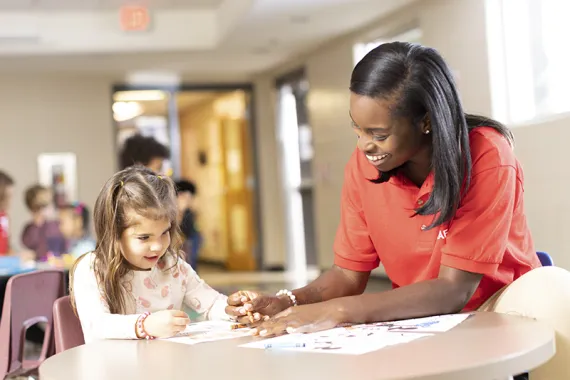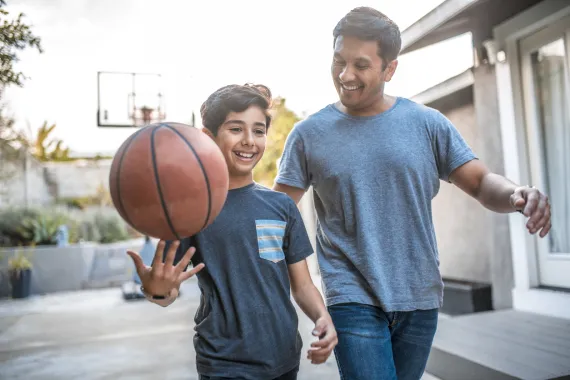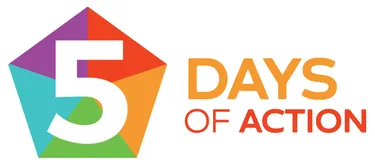The Five Days of Action are about raising awareness and inspiring and educating adults to protect children.
Research shows that increased stress levels among parents is often a major predictor of physical abuse and neglect of children. The support systems that many families relied on have reduced or no availability in many areas nowadays due to limited contact as a result of the pandemic. Child protection agencies are experiencing strained resources with fewer workers available, making them unable to conduct home visits in certain areas. Since some children aren’t physically attending school, teachers and school counselors are unable to witness the signs of abuse and report to the proper authorities.
The YMCA of Metro Atlanta is dedicated to caring for everyone in our community. We gladly take part in Five Days of Action because it’s incredibly important for at-risk children that the people in their lives are aware of the signs and know how to respond.
If you’re in an immediate emergency, call 911. However, there are a variety of non-emergency resources available.
- Disaster Distress Helpline
- Call 1-800-985-5990 (press 2 for Spanish)
- Text “TalkWithUs” for English / “Hablanos” for Spanish to 66746
- Spanish speakers from Puerto Rico can text “Hablanos” to 1-787-339-2663
- National Suicide Prevention Lifeline
- Call 1-800-273-8255 for English
- Call 1-888-628-9454 for Spanish
- Message the Lifeline Crisis Chat
- National Domestic Violence Hotline
- Call 1-800-799-7233
- Text “LOVEIS” to 22522
- National Child Abuse Hotline
- Call or text 1-800-422-4453
- National Sexual Assault Hotline
- Call 1-800-656-4673
- Message the Online Chat
- The Eldercare Locator
- Call 1-800-677-1116
- Veteran’s Crisis Line
- Call 1-800-273-8255
- Text 838-8255
- Mess the Crisis Chat
Find a health care provider or treatment for substance use disorder and mental health.
Know How Abuse Happens
If we don’t understand child sexual abuse, we can’t end it. The greatest risk to children doesn’t come from strangers, but from friends, family, or people the family trusts. People who abuse children look and act just like everyone else. They often go out of their way to appear trustworthy, seeking out settings where they can gain access to children. Abuse happens whenever a stronger or more powerful person asserts themselves against the will of another less-powerful person. Essentially, abuse starts as a boundary violation. One way to protect the children in your care is to teach them about healthy boundaries, and discuss your boundaries with adults and other children.
Schedule time to speak with your kids’ youth-serving organizations (YSOs). YSOs are activities and programs that your child is involved in, like summer camp. Ask YSO leaders about how they protect kids while in their care.
Here are some examples of what to ask:
- Ask them for a copy of their child protection policy. Does the policy include limiting isolated one-on-one situations?
- How are employees and volunteers screened? Best practices include an in-depth application, personal and professional references, criminal background check, and an extensive interview.
- Do older and young children interact? If so, how?
- Are there clear procedures for reporting suspicions or incidences of abuse?
- Are staff and volunteers trained in child sexual abuse prevention training?
- Can parents tour the facilities?
Create a family code of conduct—a set of guidelines that reflect the values of your family. Parents and caregivers are responsible for setting and enforcing these boundaries because they help protect your children. Remember, as kids grow, some boundaries and guidelines will need to be adjusted and/or added. Make sure to discuss the guidelines with your kids and get their input. Ask them what they think and what they want to include. Having the written list will make it easier to communicate your rules to babysitters, other adults, and programs/organizations your child is involved in.
Some examples of topics to include:
- Play Dates: Who will be at the house? Will there be older siblings? How do they supervise? How well do you know the family?
- Photos: Is anyone allowed to post photos of your children?
- Sleepovers: Will you allow your child to participate in sleepovers? What are the sleeping arrangements? These guidelines may overlap with play dates.
- Babysitters: How do you choose who babysits? What are the rules for babysitters? What are the rules for evening sitting vs. daytime sitting?
- Internet and Social Media: At what age will they get a cell phone or social media? How will you monitor use? Where will devices live at night? Discuss what information should never be given out online.
- Programs, Camps, etc.: What are the safety policies? What does supervision look like? These guidelines will overlap with your youth-serving organization guidelines.
See the Warning Signs
The signs of abuse aren’t always obvious, but they are often there. Sometimes there aren’t even external, physical signs that a child is being sexually abused. However, emotional or behavioral changes in a child are common. Examples of these types of changes include: physical aggression and rebellion, anxiety, depression, withdrawal, “too perfect” or overly compliant behavior, nightmares, bed-wetting, bullying, cruelty to animals, and a lack of interest in friends, sports, or other activities.
Offenders often operate through a process called “grooming.” Child grooming is the deliberate process of gradually initiating and maintaining a relationship with victims in secrecy. Grooming allows offenders to slowly overcome boundaries long before abuse occurs.
On the surface, grooming a child can look like a close relationship between the offending adult, the targeted child and (potentially) the child’s caregivers. The grooming process is often misleading because the offender may be well-known or highly regarded in the community. As a result, it’s easy to trust them.
If you know what red flag behaviors to look for you can take action and intervene when a child is vulnerable or uncomfortable. Here are some examples of red flag behaviors and examples of how to intervene:
Special Attention/Preference to a Child
Offenders are often seen pressing boundaries and breaking rules but are rarely caught in the act of abuse. When you see a boundary being crossed, describe the inappropriate behavior to the person who crossed the boundary. Have family rules about when and how adults engage when your children (great to add to your family code of conduct).
“We don’t let Jimmy go to the movies alone without a parent.”
Gift Giving
Gift giving of any expense—large or small—is a grooming technique used to flatter children and their families into trusting the individual. If another adult is overly interested in your child and family, consider this a red flag.
“It is so generous that you gave Chloe this jewelry, but we only allow gifts on birthdays.”
Touching or Hugging the Child
Offenders will test the limits by starting to introduce touch into the relationship. They might put their arm around the child or ask for a hug to see how the child reacts. They may do it in front of other adults. If the caregiver does not intervene or object, and the child is uncomfortable, it can confuse the child on what type of touch is appropriate. When you defend your child from uncomfortable touches, you build trust with the child and dissuade the offender.
“It looks like you are forcing Annie to hug you. She looks uncomfortable, please stop. We let Annie decide if and how she wants to show affection.”
Sympathetic Listener
The offender will often listen to the child when they are excited or upset. They will start to build barriers between the child and their parents and friends by telling the child they care for them more than anyone else. Be open with your kids, let them know that even people they love can hurt them. Tell your children you will always be there for them and they can tell you anything. Do your best to listen to your kids, even when the days are hectic.
“Surprises make people happy. We don’t want to keep a secret though because secrets can make people upset or unhappy. If anyone wants you to keep a secret, tell Mommy or Daddy. You can tell us anything.”
Offers to Help the Family
The individual will offer to do special favors or help the caregivers to gain alone time with the child. Be sure to let other adults know that you do not approve of them being alone with your child without your permission or knowledge. Check-in regularly so other adults know you are watching.
Drop in unexpectedly on a babysitter. Stay for the entire soccer practice, even until the last child leaves.
Gaining Access Via the Internet
Perpetrators will often pretend to be someone they aren’t to gain access to kids online. They will pretend to share similar interests to gain trust, grooming them online. Know who your kids are talking to online.
Monitor what apps your children use and have limits to when and where they can use their devices. Perhaps at night, tablets, phones, and computers live in the caregiver’s room.
Respond Quickly to Prevent it
There are three instances in which we need to react to sexual abuse: a child discloses abuse to us, we discover sexual abuse ourselves, or we have a reason to suspect it. Speaking out can be scary. What if you don’t know all the details? What if you aren’t 100% sure? Report it anyway. Legally, you do not need proof that abuse is occurring to make a report, only reasonable suspicion. Reporting child sexual abuse is key to preventing and intervening in abuse.
If a child disclosed abuse to you, they have taken a big risk. What you do next is very important. Take a deep breathe and give attention, compassion, and belief.
Here are some things to keep in mind:
- Listen calmly and openly.
- Don’t fill in the gaps.
- Don’t ask leading questions about the details.
- Ask open-ended questions like, “What happened next?”
- Let them know you believe them and that it isn’t their fault.
- Don’t overreact. When you react to a child’s disclosure with anger or disbelief, the child is likely to feel even more ashamed, shut down, or change or retract the story.
- Say, “I believe you” and “what happened is not your fault.”
- Don’t promise that the information will be kept confidential.
- Seek the help of a professional who is trained to talk with the child about sexual abuse. Let the professional collect the details from the child. Head to FiveDaysOfAction.org to find Child Advocacy Centers and other resources in your state.
- Report sexual abuse to the police or to child protective services. Be clear and specific.
Stay Safe Online
Technology and the internet connect people worlds apart, but there are also dangers that come along with the internet. Whether playing games, learning, or socializing with friends, they’re in front of a screen more than normal. So, how do you ensure they are staying safe online? By talking to your kids, educating them, and putting safeguards in place, you can help them have safer digital experiences. It’s important to set ground rules, be proactive, and keep the lines of communication open between parents and kids.
-
You may already have rules around device and internet use. Discuss how these new scenarios will affect your current rules and establish clear guidelines on which sites, apps, and downloads they can access.
-
If your child is doing virtual learning, be sure to connect with their teacher and school to get the specifications of what software and platforms they will be using and familiarize yourself with them.
-
Keep your kids on a schedule with their virtual learning and online activities so you know when and what they are doing. Be sure to include time away from devices in the schedule.
-
Discuss the importance of never giving out identifying information such as name, address, neighborhood, and phone number online.
-
Know that you may need to adjust device and online time limits to reflect your new environment.
-
Have rules about where devices live and can be used – public parts of the house where you can easily monitor their activity. At bedtime have rules around turning off devices and not having them in bedrooms.
-
If possible, connect with your children before, during, and after online use, just like you would if they were going to school or to a friend’s house. Know who they will be with virtually, where they are going virtually, and what they will be doing.
-
Talk to them about the apps and services they use, and how they use them to communicate. Pay attention to games and gaming systems, which often have online communication capabilities. Chatting can be an enjoyable activity that accompanies digital fun and learning, but it requires oversight and parental involvement.
-
Online enticement happens across all platforms so ask questions, research, and be involved in your kid’s online games and apps. Ask them to show you how they use them and do it together. For example, make an Instagram Story with your kids – this way you learn how it works and can see what they are doing on the app. You can also ask some questions based on this scenario – what would they do if they saw an inappropriate video? Do they know where the report button is?
-
Now that kids are not getting physical time with their friends, they may be livestreaming or video chatting with friends and family. According to the National Center for Missing and Exploited Children, livestreaming platforms give access to millions of people at the touch of a button, including individuals who may wish to harm children. These individuals are aware of the unique vulnerability of children online and often entice children to undress, expose themselves on camera, engage in sexual activity independently and with others (i.e. siblings, friends, pets), and engage in self-harming behaviors. Have rules around when and where they can livestream and video chat – for instance, in open, interruptible spaces like living rooms and in the kitchen.
Pledge to Protect
Download your own Pledge to Protect Card. This card will encourage you to KNOW, SEE, and RESPOND to the signs of sexual abuse to help protect children.
References
Townsend, C. Rheingold, A.A., (2013) Estimating a child sexual abuse prevalence rate for practitioners: A review of child sexual abuse prevalence studies. Charleston, S.C., Darkness to Light. Retrieved from www.D2L.org.
Finkelhor, D. (2012) Characteristics of crimes against juveniles. Durham, NH: Crimes against Children Research Center.
Julia Whealin, Ph.D. (2007-05-22). “Child Sexual Abuse.” National Center for Post Traumatic Stress Disorder, US Department of Veterans Affairs.
Materials are derived from the YMCA of the USA’s “Know. See. Respond.” copyrighted in 2020. Content provided by Darkness to Light. To learn more or get trained to prevent, recognize, and react responsibly to child sexual abuse visit www.D2L.org.





